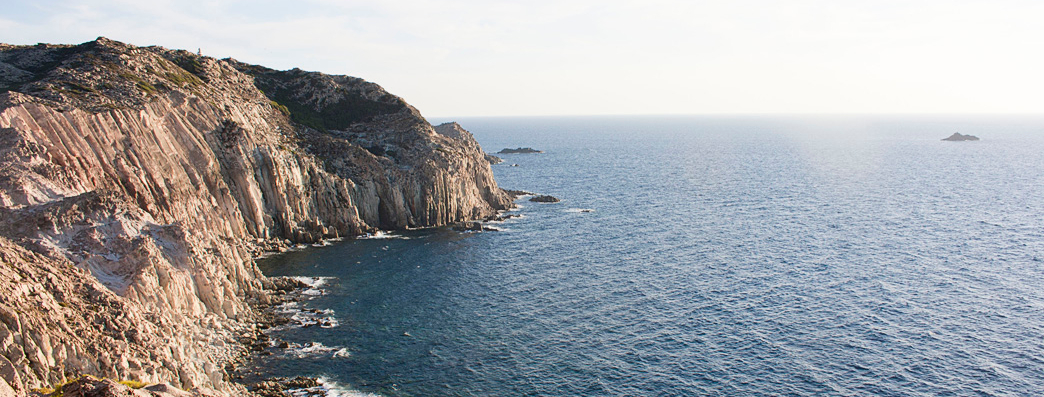
Thousands of years ago the Phoenicians called it “Inosin”, for the Greeks it was “Hierakon Nesos”, while in Roman times it was known as “Accipitrum Insula”; during the centuries the original meaning of its name has not changed: “Falcons’ Island”, underlining its main feature that fascinated the sailors who approached the western coasts of Sardinia, perhaps travelling to the ancient and important cities of Tharros (in the Sinis peninsula) and Bithia (near today’s Chia).
Today, this island on the island, which has remote volcanic origins, (renamed “San Pietro” in recent times), continues irresistibly to attract numerous flocks of birds belonging to a rare endemic species of the Mediterranean, the “Eleonora’s falcon” (Falco Eleonorae), which here come in great numbers in spring after a very long migration from Madagascar and East Africa, after having travelled even over 10,000 miles, much of which over the vast and arid Sahara desert.
The Latin name of these majestic birds praises the work of environmental protection of the “judge” Eleonora d’Arborea, a Sardinian regent and legislator who, around the fifth century, promulgated the “Carta de Logu”, a modern and complex collection of laws that, among others things, expressly prohibited to hunt hawks and pick up eggs and chicks from their nests.
“We state and order: no man shall pick up goshawks or falcons from the nest. And in case someone takes them, the Curator of the curatoria he belongs to is obliged to arrest him and bring him to us, otherwise the same Curator will have to pay a fine of five liras.” (Carta de Logu, Art.87).

Today, the distributional area of the species in the island falls entirely within an oasis of fauna protection created by Lipu (Italian Bird Protection League), extending over 414 hectares, including the 7 km of coastal perimeter on whose high and steep cliffs these birds of prey nest. Here in April, after the migration, about 120 monogamous couples come back to reproduce, going to reoccupy the same nest of previous years.
The reproduction area of the Eleonora’s falcon includes part of the Mediterranean basin, with mainly European large colonies in Greece, Cyprus, Turkey, Croatia, Serbia, Montenegro and Spain, some colonies on the North African coast (Algeria and Tunisia) and a few Atlantic nesting sites (Morocco and the Canary Islands). In Italy the species can be seen as nesting only in Sicily (Lampedusa and Aeolian Islands) and in Sardinia, where, besides the Island of St. Peter, it frequents the nearby Isola del Toro and the cliffs of the Gulf of Orosei.
They are gregarious birds, nesting in colonies generally placed on uninhabited islands or inaccessible cliffs overlooking the sea. The deposition takes place on narrow cornices or rock steps.
Mostly insectivorous in the pre-reproductive period, they radically change their diet in the egg-laying period (August-September): they take advantage of the autumn return from Europe to Africa of small migratory birds, which pass here and concentrate in large numbers to feed their chicks, by capturing their preys predominantly in flight with quick hits. Young people are lovingly cared for and can fly away after 35-40 days, then they embark on a new trip to Africa in October or November.
Another curiosity is represented by the presence of varieties with two different colours of plumage, a dark one and a more common clear one, whose meaning is not yet understood.

The oasis has several and valuable habitat types. Climbing on the ancient and contorted volcanic rocks, on which you can easily recognize the signs of lava flows along the well-placed paths, is an experience that gives a weird feeling of crossing a wild and surreal territory whose almost lunar semblance is broken from time to time by a splendid Mediterranean vegetation, which includes endemic species: from the Reef garrigue , a variegated botanical association of several small plants (Helichrysum, Citrus limon, rushes, Crithmum maritimum, Bocconi fennel, etc.) , to the rich shrubbery of Mediterranean “macchia” (including Juniper, Pistacia Lentiscus, Oleaster , Phillyrea and the characteristic Aleppo pine).
Once arrived at the top of the cliff, and immediately overlooked and surrounded by the hawks that are watching us, we are inevitably entranced by their aerial exhibitions and beautiful high-altitude flights with sudden nosedives and glides on the water coat, in an attempt to intercept and grasp their small preys exhausted by the long journey.
Looking at their landings and departures from the rocky wall you may sometimes have the chance to spot their bare nests, where one or more chicks impatiently await the parents’ return with their meal.
Tourists’ observation must, of course, always ensure the tranquillity and safety of these shy animals, and must be carried out in accordance with the criteria dictated by common sense, i.e. right distance, use of binoculars and telescopes and, preferably, under the expert guidance of responsible for the sanctuary, so as to ensure that no discomfort, even involuntarily, occurs to the majestic birds.
Obviously other typical species frequent the area, and sometimes you may have the opportunity to spot the flight of a Pilgrim Falcon, of the rare Audouin’s gull, or some European shag.
The vast and calm blue sea and the pleasant scent of saltwater complement the extraordinary beauty of a unique and spectacular landscape, of which it is difficult not to keep a wonderful memory.
Translation by Maria Antonietta Sessa



